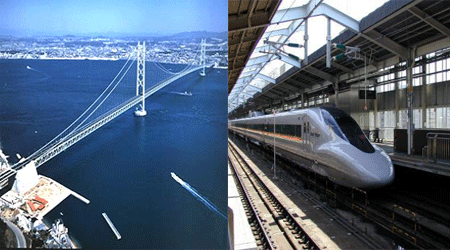
Shinkansen – The world’s fastest passenger bullet train which is located in Japan flies by us when we are on our Good News travel in Japan. We then board it and on our way look for the Akashi Kaikyo Bridge (Pearl Bridge) . Our dear friend from Asian Fusion Rick Lin and I, Paul Sladkus have a good time looking for the bridge. Our trip was fantastic as we flew on the exceptional China Airlines through their new route to Osaka, Japan, and for most they go on to Taiwan. This trip was for media and brought to us by China Airlines and The Foundation for Kansai Region promotion. We traveled along with the leading Asian media in America; Asian Fusion Magazine, The Sing Tao and The World Newspaper and had a special time. Everyone was so gracious and it was a trip to remember for a life time. In fact, Good News is creating a similar trip right now to go to Japan, so if interested please contact us at: paul.sladkus@goodnewsbroadcast.com. We will also be sharing more posts from Japan. Please become a member of www.goodnewsplanet.com and share your video/audio/text/comments of your trip to Japan and Taiwan.
The Shinkansen, also known as the “Bullet Train”, is a network of high-speed railway lines in Japan operated by four Japan Railways Group companies. Starting with the Tōkaidō Shinkansen in 1964, the network has expanded to currently consist of 2,387.7 km (1,483.6 mi) of lines with maximum speeds of 240–300 km/h (149–186 mph), 283.5 km (176.2 mi) of Mini-shinkansen lines with a maximum speed of 130 km/h (81 mph), and 10.3 km (6.4 mi) of spur lines with Shinkansen services.[2] The network presently links most major cities on the islands of Honshu and Kyushu, with construction of a link to the northern island of Hokkaido underway and plans to increase speeds on the Tōhoku Shinkansen up to 320 km/h (199 mph).[3] Test runs have reached 443 km/h (275 mph) for conventional rail in 1996, and up to a world record 581 km/h (361 mph) for maglev trainsets in 2003.
Shinkansen literally means new trunk line, referring to the tracks, but the name is widely used inside and outside Japan to refer to the trains as well as the system as a whole. The name Superexpress (超特急 chō-tokkyū?), initially used for Hikari trains, was retired in 1972 but is still used in English-language announcements and signage.
The Tōkaidō Shinkansen is the world’s busiest high-speed rail line. Carrying 151 million passengers a year (March 2008),[4] it has transported more passengers (over 4 billion, network over 6 billion)[5] than any other high speed line in the world.[6] Between Tokyo and Osaka, the two largest metropolises in Japan, up to thirteen trains per hour with sixteen cars each (1,323 seats capacity) run in each direction with a minimum headway of three minutes between trains. Though largely a long-distance transport system, the Shinkansen also serves commuters who travel to work in metropolitan areas from outlying cities.
Before the Akashi Kaikyō Bridge was built, ferries carried passengers across the Akashi Strait in Japan. This dangerous waterway often experiences severe storms and, in 1955, two ferries sank in the strait during a storm, killing 168 people. The ensuing shock and public outrage convinced the Japanese government to develop plans for a suspension bridge to cross the strait. The original plan called for a mixed railway-road bridge, but when construction on the bridge began in April 1988, the construction was restricted to road only, with six lanes. Actual construction did not begin until May 1988, and the bridge was opened for traffic on April 5, 1998. The Akashi Strait is an international waterway that necessitated the provision of a 1,500-metre (4,921 ft)-wide shipping lane.

